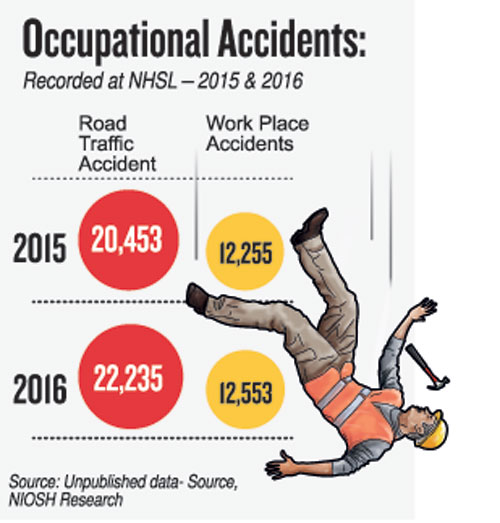Sunday Times 2
Is your workplace a safe place?
How many of us are actually familiar with the fire exits of our workplaces? How many of us actually know to handle a fire extinguisher? How many factory workers are capable of preventing or mitigating accidents? The bitter truth is that we take safety at work for granted.

National Institute of Occupational Safety and Health Director General Dr. Champika Amarasinghe
The recent toxic gas inhalation tragedy in Horana and the collapse of a warehouse in Grandpass speak for the fact. A recent study by the National Institute of Occupational Safety and Health (NIOSH) reveals that the margin between the number of work-related accidents and road accidents is not so huge. However, the National Hospital (NHSL) statistics show that 12,553 work-related accidents were reported in 2016, as against 22,235 road traffic accidents. This is because such accidents are often not officially recorded as work-ralated accidents.
As NIOSH Director General Dr. Champika Amarasinghe tells the Sunday Times, the practice of reporting them as ‘work-related accidents or deaths’ is virtually non-existent in the country, with the exception of NHSL. “This often dilutes the gravity of the situation as available statistics actually do not reflect the magnitude of the problem,” notes Dr. Amarasinghe.
The arrest of a factory owner or compensating for a lost limb is not the end of the story. What is at stake is human life which cannot be quantified. Occupational safety and health (OSH) is a multi-disciplinary concept, for which the tri-pronged proactive participation of employers, employees and the community is vital, stresses the NIOSH Chief. The commitment, she notes, should go beyond legal provisions by creating enhanced OSH literacy among the people.
Occupational safety is a grave concern within the informal economy which considers it ‘insignificant’ and at the same time ‘an extra cost.’ “Although accidents can happen even in the safest working environments, the chances are minimised by the bigger industrial players who adhere to the best practices,” notes Dr. Amarasinghe who calls for an integrated mechanism of reaching out to the small-scale factories of the informal economy. This should ideally be a collective networking system comprising community level health workers, labour officers and other relevant grassroots level stakeholders.

Employers Federation of Ceylon Director General Kanishka Weerasinghe
The Factories Ordinance and the subsequent amendments brought to it presently provide legal provisions for OSH. The relevant law was given more teeth by the National Policy initiated in 2014. The proposed Occupational Safety, Health and Welfare Act which is to repeal the Factories Ordinance, still remains a pipedream although the need for it is deeply felt. The proposed legislation offers a broader definition of a ‘workplace’ — replacing the ‘factory’ — to include any premise where work is carried out by one or more persons and covers premises used for the storage of tools, machinery, equipment or substance.
Expressing her concerns over the proposed provisions for the mandatory presence of a safety and health officer at workplaces with more than one hundred workers, Dr. Amarasinghe opines that the ceiling should be brought down as several small-scale factories have less than 100 workers. However, mere presence of an officer would not work, unless the person is competent and qualified. The presence of a safety and health officer, although mandatory by law at construction sites, is not often adhered to in reality, other than by the established large scale players, she says.
The Higher National Diploma in Occupational Safety and Health — now made possible by the NIOSH especially in view of the booming construction sector — aims to strengthen safety measures and thereby mitigate the occupational hazards in the sector. Additionally, the diploma, which is an accredited National Vocational Qualification, enables a new career path for many.

Labour Commissoner General A. Wimalaweera
The National Certification System, envisaged by the NIOSH in collaboration with the other industry players, is an ambitious move to create a system of a ‘home-grown standard’ for the industries, especially the smaller ones. The exercise is also partnered with the Employers’ Federation of Ceylon (EFC). “Multinationals companies in Sri Lanka and some local industries on par with these global giants adhere to the internationally accredited ISO standards which, the small scale players cannot often abide by due to the cost factor,” she says. She expresses hope that the proposed standard system will fill this gap.
Every year around 2.78 million workers die worldwide due to work-related accidents and disease, according to the latest global estimates by the ILO. More than 85 percent of these cases are attributed to occupational illnesses. Non-fatal injuries affect around 374 million workers around the world, while young workers — those between the ages of 15 and 24 — are disproportionately affected by work-related illness and accidents.
In such a global setting and in the wake of the recently reported local accidents at work, “there cannot be any compromise on the OSH,” notes the Director General of the EFC, Kanishka Weerasinghe. With the rising ageing population and youth becoming a ‘rare resource’, intervention at the grassroots level to strengthen OSH standards at work is imperative, he adds.
The community level task force mooted by the EFC is envisaged to be an intervention to prevent unwarranted consequences, points out the EFC Chief. The Task Force, he says, should be ready to mobilise immediately in the event of any complaint or accident in a manner that the ill-effects of such incidents are kept to a minimum. “The EFC and its membership have been at the forefront of promoting best OSH practices over the years. The proposed EFC-NIOSH collaboration, a public-private partnership, is another of the many initiatives of the EFC to promote the creation of sustainable OSH compliant enterprises island-wide. We are confident that it will be a boon to local industries, which are keen to prosper in business whilst ensuring worker welfare,” maintains Mr. Weerasinghe. He adds: This intervention will also cover what matters to workers, which is a key element in ensuring productivity and competitiveness. It is hoped that by creating greater awareness of the benefits of OSH at the workplace, more employers will be encouraged to implement and maintain these values; a strategy that will enable all stakeholders to commit resources towards ‘prevention’.
 To give validity to the ILO Convention 155 on OSH, which we are yet to ratify, it is imperative to have the proposed Occupational Safety, Health and Welfare Act in place, says the Commissioner General of Labour, A. Wimalaweera. “At the same time formulating a strategic plan on labour inspection and benchmarking ourselves with regional best practices, like those of India, Malaysia, South Korea and Singapore, are essential,” he adds. Collating information on industries as ‘high, medium and low risk’, possibly through an industrial survey is also mooted by Mr. Wimalaweera.
To give validity to the ILO Convention 155 on OSH, which we are yet to ratify, it is imperative to have the proposed Occupational Safety, Health and Welfare Act in place, says the Commissioner General of Labour, A. Wimalaweera. “At the same time formulating a strategic plan on labour inspection and benchmarking ourselves with regional best practices, like those of India, Malaysia, South Korea and Singapore, are essential,” he adds. Collating information on industries as ‘high, medium and low risk’, possibly through an industrial survey is also mooted by Mr. Wimalaweera.
Training labour officers in OSH with the ILO’s technical support and building a network of grassroots stakeholders to elicit information on hazardous industries and occupational hazards and thereby making necessary interventions are also envisaged by the Labour Department.
To champion a ‘safety culture’ in the country, the effort should go beyond legal provisions and labour inspections, notes the Labour Commissioner who calls for other proactive measures such as employer contribution to OSH, introduction of a mandatory OSH module to national level vocational training and engaging visual arts on OSH.
The changing dynamics of industries and workplaces call for increased OSH, points out Mr. Wimalaweera, noting that their sustainability will largely depend on it. “We hardly see any clauses related to OSH in collective agreements. Trade Union activism should also draw attention to this vital component of economic literacy as we simply cannot afford to compromise the most productive populace of our work force.”

